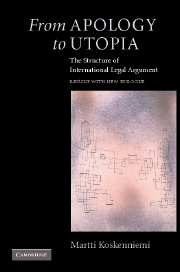Book contents
- Frontmatter
- Contents
- Preface to the reissue
- Acknowledgements
- List of abbreviations
- Introduction
- 1 Objectivity in international law: conventional dilemmas
- 2 Doctrinal history: the liberal doctrine of politics and its effect on international law
- 3 The structure of modern doctrines
- 4 Sovereignty
- 5 Sources
- 6 Custom
- 7 Variations of world order: the structure of international legal argument
- 8 Beyond objectivism
- Epilogue (2005)
- Bibliography and Table of cases
- Index
3 - The structure of modern doctrines
Published online by Cambridge University Press: 16 July 2009
- Frontmatter
- Contents
- Preface to the reissue
- Acknowledgements
- List of abbreviations
- Introduction
- 1 Objectivity in international law: conventional dilemmas
- 2 Doctrinal history: the liberal doctrine of politics and its effect on international law
- 3 The structure of modern doctrines
- 4 Sovereignty
- 5 Sources
- 6 Custom
- 7 Variations of world order: the structure of international legal argument
- 8 Beyond objectivism
- Epilogue (2005)
- Bibliography and Table of cases
- Index
Summary
I shall not attempt an exhaustive review of modern international legal doctrines or theories advanced by modern lawyers to explain why international law is something other than politics. My focus will remain with the argument's “deep-structure”, that is, the conditions within which express argument is possible. I am less concerned about what lawyers have said or assumed than what they need to say or assume in order to think their work coherent. From this perspective, modern discourse will appear as the constant production of strategies whereby threats to the argument's inner coherence or to its controlling assumptions are removed, or hidden from sight, in order to maintain the system's overall credibility.
Modernism shares the classical problématique, involved in its adoption of the liberal theory of politics. It tries to explain why the law it projects is both normative and concrete – that is, not vulnerable to the criticism of being apologetic or utopian. But these explanations threaten each other. To remove – or explain away – the threat, doctrine may adopt four strategies. It may prefer normativity or concreteness, renounce both or explain them as compatible. These are exhaustive and logically exclusive positions and will count as a full description of the modern argument's structure.
I shall first describe the method whereby it has been possible for a distinctly “modern” discourse to emerge from a criticism of classical doctrines as subjective because either apologetic or utopian (3.1).
Information
- Type
- Chapter
- Information
- From Apology to UtopiaThe Structure of International Legal Argument, pp. 158 - 223Publisher: Cambridge University PressPrint publication year: 2006
